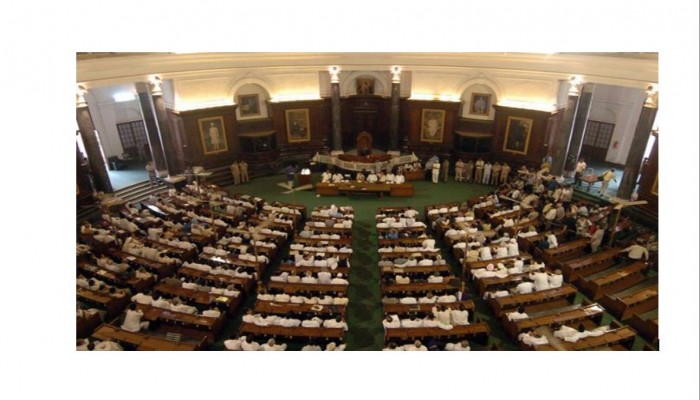How the Ideas of Right-Wing and Left-Wing Divide India
- In Current Affairs
- 11:46 AM, Nov 24, 2017
- Dr. Bhuvana Narayanmurthy
One of the biggest misnomers that distorts, divides and wreaks havoc on current social thinking in India, is the labeling of political parties as right-wing and left-wing by the media. This is one of the more cancerous implants from Western societies, applied to the Indian context without thought, knowledge or understanding. On the other hand, this implant could be deliberate, as speculations abound regarding foreign ownership of Indian media outlets.
Whether intended or not, the use of the terms “right-wing” and “left-wing” to describe the positions of political parties in India is problematic. This is because the social conditions in India do not neatly fit the social conditions in Europe where these terms originated. Let’s take a deeper look.
Origins of Right-wing and Left-wing in the Political Spectrum
It all began during the French Revolution. In the late 18th century France boiled over with social unrest and anger directed at the ruling class. The French king, Louis the XVI, mismanaged France’s finances badly by leading expensive wars and living a lavish lifestyle. The nobility, who did not pay taxes, also enjoyed the privilege of living luxuriously. All the while the impoverished working class had to pay increasing taxes to meet these expenses. This created a grave economic divide in France, which was a key reason for the working-class majority to rise up against the wealthy nobility.
To contain a growing revolt against the monarchy and the nobility the French king invited members of the working class to participate in the workings of the French court. Those who were in favor of the king, mainly the noblemen, occupied the seats to the right of the throne and the working-class representatives occupied those to the left. This seating position eventually became equated with the ideologies of each group.
The right-wing nobility favored the king, supported all the privileges that were associated with the ruling class and supported the Catholic Church; therefore, they were seen as “conservatives” who did not want social change. The left-wing, in contrast, did not want the old social order to be perpetuated as it left them at a disadvantage. They proposed newer, more egalitarian ideas that included liberalism, republicanism, socialism and communism - i.e., those ideas that would help remove the French system of hierarchy and eliminate the socio-economic differences between haves and have-nots. They advocated secularism, which emphasized that there should be a separation between the Church and State, as the Catholic Church controlled and dominated social and political policies of the king[1].
Right-wing and Left-wing in Britain
The terms right-wing and left-wing in Britain[2] began to be used denote ideologies similar to those in France - the Right wing “conservatives” (called “Tories” today) supported issues that promoted their privilege[3]. They did not (and still do not) believe in wealth re-distribution - i.e., they believe in capitalism and in the notion that each must pay for his/her own education and health care. The left-wing “Labour” party believes in issues that provide better opportunities for the working class, which means changes to the traditional social order (often called progressive ideas). They believe in wealth re-distribution to ensure equal access to all citizens.
For example, on the recent Brexit issue, the right-wing conservatives voted for Brexit, towing the ideological line of nationalism (manifested as protectionism), and closed borders. The Labor, on the other hand voted to remain in the EU, and favored open borders but with tighter scrutiny.
Right-wing and Left-wing in America
In America[4], the right-wing and left-wing ideologies have a broad correlation with the way it was originally conceived in France but accommodate the local issues as relevant to the times. Currently, the right-wing in America is associated with Christian conservatism, capitalism (but now with protectionism) and nationalism (manifested as closed borders and tighter immigration standards). The left-wing is associated with liberalism. As practiced in America, liberalism reflects an open attitude toward immigrants, equal opportunities for racial, cultural and religious minorities, women’s rights and cultural diversity[5]. An issue that is particularly contentious during elections is, the women’s “right to choose”. That is, right-wing people say that women should not undergo abortion under any circumstance while left-wing people say that women should have the choice to decide what is best for them.
The Misfit of Right-wing and Left-wing in India
In all the cases discussed above, there is never any question of the main religious context within which these ideologies are practiced - whether it was 18th century France, present-day Europe or America, there is one religious context common to all these countries, and that is Judeo-Christianity. America’s “right to choose” is perhaps the most telling example. Christianity, particularly, the Catholic Church, is against abortion. This power of the Church, to dictate peoples’ lives with little regard to their individual circumstances, is the substance of the debate. The opposite views on this debate are still articulated within the Judeo-Christian cultural context.
In India, however, the mainstream media pits one religion against another and calls that right-wing vs. left-wing. The native Hindu culture is seen as right-wing and is equated with the privileged position of the 18th century French nobility and the invading capitalists of Europe that plundered India. Any attempt to preserve, let alone grow, Hindu ideas is seen as being “conservative”, an attempt to preserve one’s privilege much like the wealthy, non-tax-paying medieval European nobility; therefore a horrible thing. Never mind that Hindus were never marauding capitalists like the Europeans, never mind that knowledge, wealth and military might were never in the hands of a single caste in Hinduism, never mind that Hindus were enslaved in their own country by European and Islamic powers for centuries. Mainstream media intellectuals completely disregard all of that. Practicing and discussing Hinduism should actually be seen as freedom, it should be seen as emancipation from centuries of slavery. Instead it is seen as a social privilege that must be given up!
The left-wing in India, according to the media, is composed of every group that is non-Hindu - Christians, Muslims and Communists primarily. Since Communists do not profess any religion the religious context of the left-wing, “liberals”, is primarily Islamo-Christian. Left-wing as conceived by the West is meant to be progressive, egalitarian and inclusive. Since the Islamo-Christian context is given the label of left-wing, it is being presented as progressive, egalitarian and inclusive, never mind that their religious ideas may not truly be progressive or that people from these two faiths were invaders who forcibly converted the native population largely through foul means.
What is dangerous is that, foreigners do not know or understand (best case scenario) the complex social conditions of India, therefore when they see a term like left-wing, liberals all over the world use their own versions as a reference point (which is often defined by a single religio-cultural context) to make up its meaning. Thus the war of perception is tilted against the Hindus, right-wing or not. Since mainstream media feels that the left-wing ideology should be shown to have supremacy (for whatever reason), they force-feed that ideology through ridiculous stories and selective silence.
Correlation between Current Right-wing in India and Liberalism
Core Hindu values revolve around respect for each other’s differences, particularly in religious matters, acceptance of multiple ways to practice various modes of worship, and the fundamental understanding that different people have different preferences. In other words, the Hindu society has been a grandmaster in the art of practicing pluralism centuries before the 18th century liberal French. This Indian pluralism has a strong correlation with American liberalism which believes in diversity and treating cultural others with respect.
With regard to women’s rights, Hinduism has typically done a better job of granting women’s rights in principle, but not in practice[6]. Here, there is an ideological correlation with liberalism, although Hindu practices can improve significantly.
To me, the reason that American liberals do not warm up to Hinduism is due to their perceptions of the caste system. In India it was actively propagated as a social evil by invaders in an effort to break the society and manipulate the native population. The media does not take into account the various changes that have occurred over time therefore, it consistently uses outdated arguments about the caste system to bash Hinduism and to discredit its followers while remaining silent on religious conversions. There is never any neutral discussion of the merits-demerits of the caste system. It is consistently portrayed as completely negative, much like the exploitative system of medieval Europe (which perhaps needs examination as well!). Our media intellectuals conclude that whatever happened in Europe must have happened in India too! In my view, it is due to this stance taken by our media intellectuals that Americans in general and liberals in particular, do not understand critical facts about India.
Importance of Understanding that the Words Right-wing and Left-wing are Misfits in India
In current times, we seem unable to escape wars of perception. Winners and losers are no longer decided just on the battlefield, they are picked based on perceptions. Important tools in creating these perceptions are the choice of labels assigned to social/political practices, ideology and phenomena. In other words, perceptions are created through words. Therefore, it is important to use the right words to ensure that everyone shares the same meaning, because you cannot win a war of perception if you have to keep explaining yourself.
[1] There are plenty of online sources that can attest to these well-documented facts.
2 I’m using the specific example of Britain as much of modern Indian history is derived from British history.
3. In today’s politics right-wing and left-wing have various shades - alt-right, alt-left, neo-conservatism, neoliberalism etc. Also, nuances like republicanism, once seen as left-wing in France, but now being seen as right-wing in the US, are not handled here. Getting into those details is not within the scope of this article.
4 I use America as a second example as it is one of the popular references that influence public intellectuals in India
5 There is a long history of how right-wing and left-wing ideologies have evolved over time. Addressing that history is not within the scope of this article.
6 This is a vast subject that requires deeper analysis, therefore not dealt with here. Treatment of women typically varies within communities and also within families. These nuances are almost never discussed in the media.







Comments